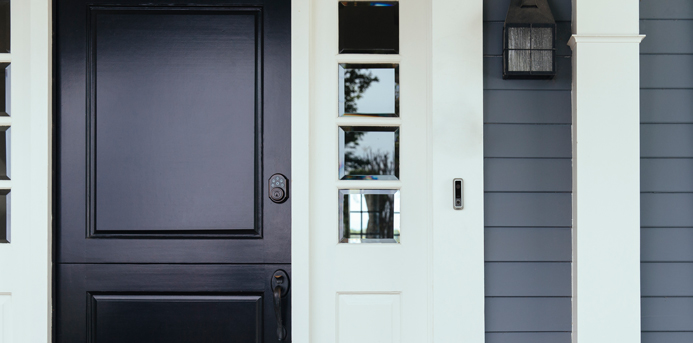You wake up in a cold sweat. You have a vague feeling that all of your belongings are gone and the kids are missing. Your eyes scan the room and as they adjust to the light, you breathe a long, hard, sigh of relief. It was just a terrible dream.
Unfortunately, as far as nightmares go, the threat of a home invasion has a higher chance of becoming reality than, say, a zombie apocalypse or walking to work naked. In fact, a home burglary occurs every 15 seconds in the United States.
Unlike the masked villain of campy movies and old commercials, modern day thieves are much more likely to attack during daylight. So, instead of fading into the shadows and escaping into the night, a burglar will wipe you clean in broad daylight while you’re at work.
So what does one do to protect against this very real threat? Invest in an ironclad home security system, of course.
“I think instead of looking at just ‘home security systems,’ people should really look for smart home systems,” says Hyun Lee, marketing manager at Yoga Systems – Smart Home. “When you decide on upgrading your home to a smart home, you can install security HD cameras with live feed and recording, sensors, alarms, mobile notifications, plus [you get] the benefits of automating your home.”
Indeed, security systems have made significant leaps and bounds since the days of peepholes and chained dogs. In fact, a home security system today practically doubles as a sort of digital personal assistant.
“The coolest and best feature [of my ADT system] is not needing a landline,” says Tiffany Grant, an executive assistant at the University of Chicago. “Back in the day, residents had to have a landline connected to the system. My cellphone is connected to my system and I get calls directly to my cell if ADT picks up anything.”
After suffering a break-in a few years back, Grant decided to invest in a home security system to protect her and her daughter. She chose ADT, one of the most well-known security companies, because it’s a name she “knows and trusts.”
If you want the very best in home security, where should you look?
“I think Vivint is the system to go with when it comes to bells and whistles,” says Elli Bishop, a home security expert from SafeWise.com. “It’s a little more pricey, but it’s a lot more visually appealing, and it’s easier to turn your home into a smart home.”
Vivint is North America’s largest home automation service company and offers three tiers of packages. The top package charges about $100 for installation and another $70 per month for monitoring (entry level is $50 per month).
Bishop and her team have analyzed all of the big players and place Vivint, ADT and Frontpoint in the top three spots, giving extra props to Vivint for its technological features.
The “Smart Complete” package allows for 24/7 security, full mobile access, a digital peephole, video doorbell, LED touchscreen control panel, night vision, along with thermostat and light control features.
As Bishop says, you can basically leave all the “mundane” everyday tasks to your new security system. Your plant watering, thermostat adjusting and manual music changing days are over.
But, are all these features truly necessary for the average family?
Not really, says Lindsey Hopkins, a representative of the new DragonFly security system. Many of these extras, she says, can be purchased at a hardware store.
“The crucial element in a home security system is that homeowners get a police response when they need it,” she says.
The Dragonfly system, which will launch later this year, is significantly paired down, including a Wi-Fi-connected hub with a camera that simply detects movement outside, records a 10-second video and then sends it to the homeowner.
“If the video shows a threatening situation, the homeowner can click on the ‘dispatch’ button within the app, which sends the video to a professional central station,” she explains. “The central station calls the correct jurisdiction for police response to the property.”
Canary, a home security company based in New York City, prides itself on being both simple and affordable. Yet, it boasts a twist that sets it apart from the competition – it couldn’t care less what happens outside the home. Rather than focus on a rustle in the bushes or a suspicious figure in the doorway, Canary only monitors what happens behind closed doors.
“Many home security systems – both DIY and professionally installed products – use sensors mounted on doors, windows, and walls. These complicated systems focus on the perimeter of a home, and fail to provide meaningful information about what’s actually happening inside,“ explains Canary founder Adam Sanger.
Canary uses wide-angle HD video, high-quality audio, motion and noise detection, and temperature, humidity and air-quality readings to detect any kind of movement that seems outs of the ordinary. As is the case with many of these systems, the ability to detect out-of-the-ordinary events increases significantly with time as the system gets to know your patterns and schedule.
While being able to spy on your living room while lying in a cabana on an exotic beach sounds nice, do all these gadgets really catch more crooks?
The answer? A resounding yes.
According to Priority, the Partnership for Verified Alarm Response, arrest rates for an alarm without a video were 2 to 8 percent. This equals roughly 1 out of 12,500 break-ins.
With a camera, that rate skyrockets to between 20 to 50 percent. Impressive. If that isn’t reason enough to put your life on film, we’re not sure what is.
More from Make It Better:

